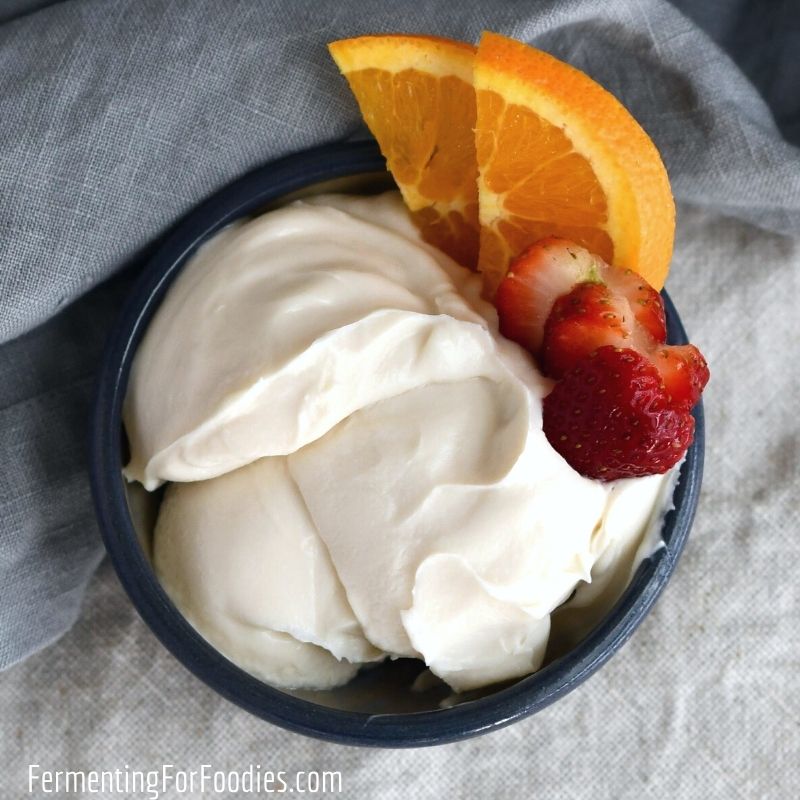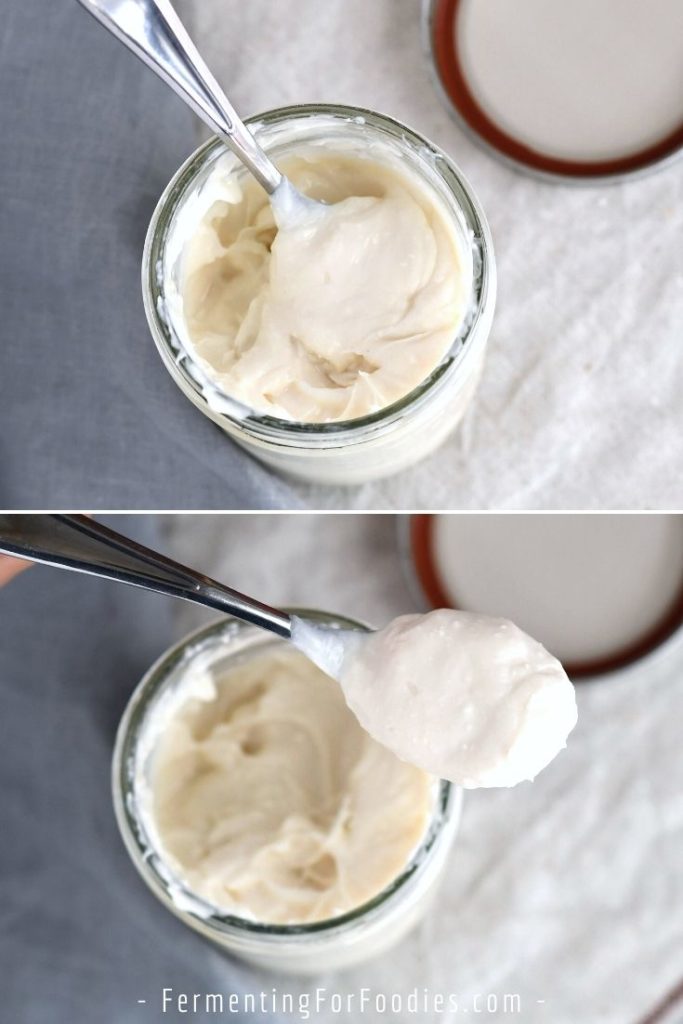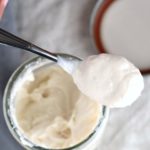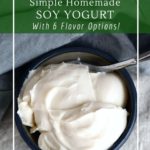Soy yogurt is a simple and delicious dairy-free yogurt option. In fact, soy milk is the only dairy-free milk that naturally thickens as it cultures. Making it the perfect option for breakfasts, snacks, or desserts.

A great dairy-free yogurt!
Soy milk yogurt is a really good, dairy-free yogurt.
- It is thicker than almond milk yogurt.
- Easier to make than cultured cashew cream.
- More mild-tasting than coconut yogurt.
- It can maintain a healthy bacterial culture so it can be repeatedly re-cultured.
How to make thick soy yogurt
There are only two tricks to successfully making soy yogurt.
- Really good yogurt culture: I have made soy milk yogurt with a few different types of culture, and never had an issue. So feel free to use a container of vegan yogurt from your local grocery store. Or if you want a particularly vigorous culture, buy vegan yogurt starter culture online. You can also use probiotic capsules. It’s a great way to test the quality of your probiotic supplement!
- Keep it warm: Most yogurt strains are thermophilic (heat-loving) and culture best at 105 F (40 C). Yogurt makers usually make several small jars of yogurt. So I actually use a folding fermentation box, which is great for everything from yogurt to tempeh. Alternatively, check out my post on how to make yogurt without a yogurt maker for some DIY alternatives.
Saving culture for future batches
The best thing about soy yogurt is that it is such a vigorous and reliable culture. So it can be saved for future batches of yogurt.
- To maintain a vigorous culture, you will need to make yogurt every 2 weeks.
- Alternatively, freeze 1/4 cup batches of yogurt to preserve the culture for up to 4 weeks (and often up to 4 months).
- I usually freeze a bit of yogurt every time I make it so that I always have a vigorous culture available.
Flavoring soy milk yogurt
Homemade yogurt is perfect for all sorts of different flavors!
Yogurt can be made from flavored soy milk. Alternatively, mix spices, flavor extracts, cocoa powder, or sweeteners before culturing. Flavors like fruit, nuts, and granola should be added right before serving.
Here are six suggested flavor combinations:
- Creamy chocolate: Either use chocolate soy milk or add 2 Tbsp of cocoa powder, 1 tsp vanilla, and 2 Tbsp of maple syrup to the batch.
- Extra creamy: Use soy creamer for a rich and thick yogurt that is perfect for dessert.
- Very vanilla: Either use vanilla soy milk or add 2 tsp of vanilla extract to the batch of yogurt.
- Maple: Add 2 Tbsp of maple syrup and 1 tsp of maple extract. Maple yogurt is delicious with toasted pecans sprinkled on top.
- Chai spice: Add in 1 Tbsp of maple syrup with 2 tsp chai spice mix.
- Fruit topped: Add 1/4 cup of homemade fruit sauce or jam when serving your yogurt.

Homemade Soy Yogurt
Soy yogurt is an easy dairy-free yogurt alternative. It’s the only dairy-free milk that will naturally thicken as it cultures! Make flavored yogurt by adding in flavor extracts, spices, and sweeteners. See the section above for 6 flavor suggestions.
- Prep Time: 10 minutes
- Total Time: 10 minutes
- Yield: 4 cups 1x
- Category: Snack
- Method: Fermented
- Diet: Vegan
Ingredients
- 2 Tbsp of vegan yogurt with live culture
- 4 cups of soy milk (see notes)
Instructions
With a yogurt maker
- If you have a yogurt maker, then you can simply mix the soy milk and yogurt culture, then let the yogurt maker heat it to the right temperature.
- Maintain at around 105F (40 C) until it is set (at least 4 hours, or if you like a strong yogurt then you can leave it for up to 24 hours). The soy yogurt should have thickened.
Without a yogurt maker
- Pour the soy milk into a small saucepan and warm it up on medium-low. The soy milk needs to get to 105 F (40 C) without burning. So heat it slowly, and whisk occasionally to keep it from scalding on the bottom of the pot.
- When the soy milk is at 105 F (40C), stir in the yogurt culture making sure it is well mixed.
- Pour the warm soy milk into mason jars or serving containers.
- Keep the yogurt warm until it is set (at least 4 hours). Wrapping it in sweaters and sticking it next to your hot water tank works well! The soy yogurt is done when it has thickened slightly.
Notes
- Using soy milk that is labeled as Preservative-Free is the best way to make sure that added preservatives don’t slow down or stop the culturing. However, I have never had an issue with using fresh soy milk, found in the refrigerated section of the grocery store. Alternatively, you could try homemade soy milk. Just avoid using shelf-stable soy milk.
- Soy milk forms a fairly thick yogurt without any added thickeners. However, if you want really thick creamy yogurt, strain the extra liquid. Line a colander
with two layers of cheesecloth
and pour in the soy yogurt. Leave it to drain for 2-3 hours. The soy yogurt will be extra thick and creamy. And the liquid can be used as a probiotic culture for fermenting grains and vegetables. It’s also perfect for adding to a smoothie.
- To make a flavored yogurt, stir in spices, flavor extracts, cocoa powder, etc. prior to fermenting. Fruit, nuts, and granola are better added when serving the yogurt. See the section above for 6 delicious flavor options.




I made this recipe yesterday for the first time, with homemade soy milk from the recipe you linked to. It did thicken up much better than the almond milk yogurt I tried (from a Cultures for Health recipe), but I am thinking it’s probably going to be an acquired taste in terms of the flavour! I tasted the soy milk on its own, then added some vanilla beans, then tasted again, then added a tablespoon of maple syrup and tasted again, then added 1/8 tsp of stevia extract (as suggested in the soy milk recipe)… but there’s still a really strong soy bean flavour. I’m trying to avoid sugar as much as possible, so don’t want to add more sweetening. I’m thinking I will perhaps have to mix it with some store bought coconut yogurt to make it truly palatable… Anyway, thanks for the recipe! It does work better than almond milk for getting more of a yogurt texture.
I’m not a big fan of soymilk either. Maybe mix it with fruit? I really like almond milk yogurt thickened with chia seeds. You can also try cultured cashew cream. (Both recipes are on my blog.) I find the cultured cashew cream to be quite sour, so I don’t recommend culturing it for too long. 🙂
Kindly send
I love this recipe! The texture is perfect. The flavor is not the best, but I think I will use half soy milk and half cashew milk for the ferment next time. Also, could I freeze cubes of yogurt for future ferments?
Yes! Cultures survive freezing and that’s the best way to save them for long-term use. For the record… I agree, soy milk is not my favourite… but I had to try it! I like coconut best. Cashew is good, but it sours really quickly so don’t ferment it as long. Enjoy!
When would I add the flavourings such as cocoa or chai spice?
You can add it before fermenting. However, if you want to save some of the culture for future batches, then add the flavor when serving it. Enjoy!
Thank you so much, I’m so excited to try! Xx
I buy plain unsweetened soymilk and there are no preservatives added but it is enriched with vitamins and minerals. Is that a problem? Also doesn’t it need to contain sugar to ferment? Thx!
That should be fine. It doesn’t need sugar to ferment. However, if it doesn’t contain any thickeners (some soymilks do) you may have a fairly runny yogurt. For a thicker yogurt, pour it through a double layer of cheesecloth, to drain away the whey. Cheers!
Thank you very much! Can’t wait to try this. I’ll report back with my results.
I’ve never made yogurt before. I’m so confused by this “To maintain a vigorous culture, you will need to make yogurt every 2 weeks.”
Also, what size cups do you recommend? 4oz, 5oz, 6oz? It’s for a always hungry toddler. 😉
Hi Olivia,
Yogurt culture will continue to ferment slowly in the fridge. Eventually, some strains of bacteria will start to die off from lack of sugars, and not being fed at a warm temperature. To keep the culture active and healthy, you either need to feed it every two weeks (by making a new batch of yogurt) or you can freeze it, which will preserve the culture for several months. I usually make mine in 1-quart jars, then serve it from there. For my family of 4, I make 2 quarts every 3 to 4 weeks, and I freeze a 1-cup jar of yogurt for the next batch. If you want to make individual servings, maybe use whatever jars you happen to have plenty of?
Cheers, Emillie
I’ve tried this a couple of times (starting with freshly made soy milk and yoghurt stirred in), but the yoghurt keys separating and I end up with about half yoghurt and half watery liquid. Any ideas what I may be doing wrong? I’ve tried lowering the temperature of the yoghurt maker, but the same happens.
It sounds like it’s working! Some types of soymilk separate more than others. It occurs because the culture is causing certain proteins to coagulate, which results in some whey being left behind. This is similar to what happens when making tofu. You can stir the whey into the yogurt, or strain it for thicker soymilk yogurt. The liquid portion is full of bacterial culture. It can be used to make future batches of yogurt. Use it in smoothies, use it to add richness to soups, or like buttermilk in baking! Cheers!
When do you add the “extras,” such as in the creamy chocolate version?
Great question! I’ll add that info to the recipe later today. Add the extras before making the yogurt. That way they will set into the whole batch. Alternatively, you could stir them in right before serving (best for fresh fruit, etc.). Cheers!
Hi! Would miso work as a culture/starter? For a saltier tangy yogurt?
Miso will definitely culture soymilk. 🙂 However, I haven’t personally tried it for a yogurt-like dip. I have used miso to make all sorts of savory cultured dips (hummus, my red lentil dip, and cashew cheese spread). I suspect the result will be more savory than you expect. If you’re using miso, there’s no need to heat the soymilk. It will culture just fine at room temperature.
If you try it, let me know what you think! Thanks! Emillie
Can I use brands like Silk to make this recipe? And also, there’s a link to a vegan culture starter powder, would I use 4 tbsp of that powder starter to add to whichever soymilk I use?
I used Silk for the photo! 🙂 The starter culture package should tell you how much to use per cup of soymilk. They aren’t all identical, so follow the package instructions. Cheers!
Do you mean that it does not work with soy milk brought from the room-temp section? There is one available with only soy, water and sea salt and I wonder why would it not work as well as some from fridge-section.
I have the same question!
I haven’t tested every brand of soymilk. However, in my local grocery store, the only brand they carry in the shelf-stable area is definitely full of preservatives. If you think the soymilk is preservative free it should work! However, depending on where you live (Canada & USA, for example) preservatives aren’t required to be labeled unless they’re in extremely high amounts. The only way to be certain is to look for preservative-free. It’s fine to try to make a batch of yogurt, just to see if it works with your favorite brand of soymilk. You’ll know if it hasn’t cultured within 8 hours.
Cheers!
Oh, makes sense. However, I live in Finland an here it is required to display pretty much all ingredients, especially since this soy milk is organic and with organic the rules are stricter. I will try once I get some working starter or probiotics again – noticed that mine are not good anymore.
It’s nice that the rules are stricter… It’s definitely better for the consumer. Cheers!
I do not have a food thermometer, ehen heating the milk, do we bring it to a boil? Or a simmer?
You only need it to be slightly above body temperature. So don’t boil the soymilk, just heat it until it’s warm (but not hot) to the touch. 🙂
I do not have a food thermometer, when heating the milk, do we bring it to a boil? Or a simmer?
Great recipe. I’ve found that whipping the yogurt with an immersion blender makes it even more thick and creamy. I’ve been experimenting with straining it to make Greek style soy yogurt which works great. I’m wondering how you use the strained liquid to ferment vegetables and grains? Thanks!
So glad that you’re enjoying your DIY soy yogurt!
You can use the strained liquid like whey (from making cheese) or buttermilk. It is an acidic liquid, full of bacterial cultures. Many of my vegetable and fruit ferments include the option of using a starter culture. It’s also good for baking, soaking overnight oats, or breaking down cornmeal to improve digestibility. Let me know if there’s something that interests you, and I’ll share a few specific recipes. 🙂
Cheers, Emillie
Thanks Millie – how would you use the whey in baking? Can you use it for sauerkraut or kombucha? I’m just getting started experimenting with fermenting. It’s a lot of fun.
Hi Eileen, Cabbage has plenty of culture on its leaves. I don’t recommend using whey to ferment it. However, you could use whey to ferment other vegetables. Kombucha has its own unique culture, a mix of yeast and bacteria. However, if they sell live-brewed kombucha at your grocery store all you need is the liquid to brew another batch! (Look for a locally brewed brand that is kept in the fridge and has warnings about needing to be kept refrigerated.)
You could use the whey as an alternative to buttermilk, like in this soda bread recipe: https://www.fermentingforfoodies.com/traditional-irish-soda-bread/
Cheers! Emillie